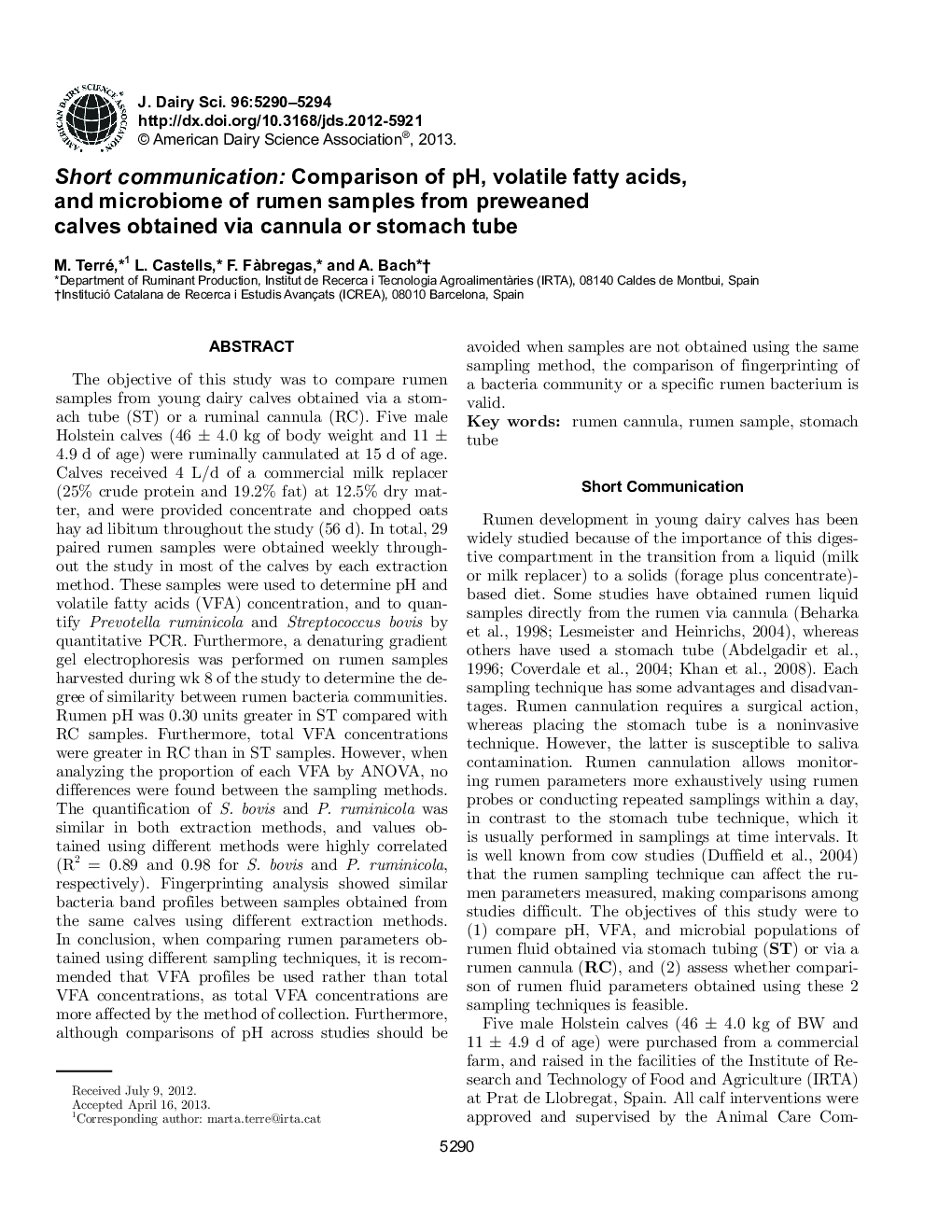| کد مقاله | کد نشریه | سال انتشار | مقاله انگلیسی | نسخه تمام متن |
|---|---|---|---|---|
| 2438906 | 1108051 | 2013 | 5 صفحه PDF | دانلود رایگان |
عنوان انگلیسی مقاله ISI
Short communication: Comparison of pH, volatile fatty acids, and microbiome of rumen samples from preweaned calves obtained via cannula or stomach tube
دانلود مقاله + سفارش ترجمه
دانلود مقاله ISI انگلیسی
رایگان برای ایرانیان
موضوعات مرتبط
علوم زیستی و بیوفناوری
علوم کشاورزی و بیولوژیک
علوم دامی و جانورشناسی
پیش نمایش صفحه اول مقاله

چکیده انگلیسی
The objective of this study was to compare rumen samples from young dairy calves obtained via a stomach tube (ST) or a ruminal cannula (RC). Five male Holstein calves (46 ± 4.0 kg of body weight and 11 ± 4.9 d of age) were ruminally cannulated at 15 d of age. Calves received 4 L/d of a commercial milk replacer (25% crude protein and 19.2% fat) at 12.5% dry matter, and were provided concentrate and chopped oats hay ad libitum throughout the study (56 d). In total, 29 paired rumen samples were obtained weekly throughout the study in most of the calves by each extraction method. These samples were used to determine pH and volatile fatty acids (VFA) concentration, and to quantify Prevotella ruminicola and Streptococcus bovis by quantitative PCR. Furthermore, a denaturing gradient gel electrophoresis was performed on rumen samples harvested during wk 8 of the study to determine the degree of similarity between rumen bacteria communities. Rumen pH was 0.30 units greater in ST compared with RC samples. Furthermore, total VFA concentrations were greater in RC than in ST samples. However, when analyzing the proportion of each VFA by ANOVA, no differences were found between the sampling methods. The quantification of S. bovis and P. ruminicola was similar in both extraction methods, and values obtained using different methods were highly correlated (R2 = 0.89 and 0.98 for S. bovis and P. ruminicola, respectively). Fingerprinting analysis showed similar bacteria band profiles between samples obtained from the same calves using different extraction methods. In conclusion, when comparing rumen parameters obtained using different sampling techniques, it is recommended that VFA profiles be used rather than total VFA concentrations, as total VFA concentrations are more affected by the method of collection. Furthermore, although comparisons of pH across studies should be avoided when samples are not obtained using the same sampling method, the comparison of fingerprinting of a bacteria community or a specific rumen bacterium is valid.
ناشر
Database: Elsevier - ScienceDirect (ساینس دایرکت)
Journal: Journal of Dairy Science - Volume 96, Issue 8, August 2013, Pages 5290-5294
Journal: Journal of Dairy Science - Volume 96, Issue 8, August 2013, Pages 5290-5294
نویسندگان
M. Terré, L. Castells, F. FÃ bregas, A. Bach,